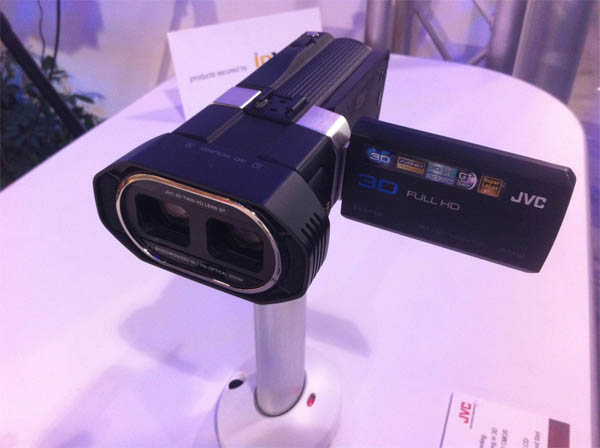
This year, MAKE/O’Reilly author Damien Stolarz (iPhone Hacks, Car PC Hacks) agreed to be our eyes and ears on the ground at CES, scoping out hardware at the show that he thought would be of interest to makers. Here’s his third and final installment, a tour of Central Hall. (Here’s his report on North Hall and the International Pavilion and his take on South Hall) Thanks, Damien! —Gareth
After a week of decompressing, I was able to look back at my CES trip and begin to digest the overwhelming audiovisual experience that was Central Hall. Central Hall is where the biggest companies can be found. Microsoft and Intel flank the west entrance, quickly followed by Panasonic, Samsung, LG, and nearly every other TV manufacturer on the planet. At the far end of Central Hall sits an enormous shrine to Sony.
A couple of major themes stood out this year:
- Tablets
- Stereoscopic 3D
- Touchscreens everywhere
- Extra sensors in everyday devices
- Wireless Power and alternative energy
The overwhelming theme was Stereoscopic 3D. Imagine a form of augmented reality where only those wearing goggles can participate. Apparently the future’s so blurry, you gotta wear shades.
Unfortunately, there are several kinds of shades to choose from. Active shutter glasses flicker each eye in sync to the screen. Passive glasses are circularly polarized, and cut the brightness but don’t have the same strobe effect.

Panasonic’s Booth had a huge video array and bleachers and hundreds of active shutter glasses.

Here you can see one of the many IR transmitters that send the left-right shutter information to the glasses.

Sony’s huge booth had a wide-stereo 3D display on loop, that used passive shutter glasses like a movie theatre. This is ironic, because all their screens use active shutter and their rep was extremely critical of passive (“It’s half the resolution”). However, there’s not really a “format war” in the traditional sense, because any stereo 3D display system can play back any 3D content.

People reacted to Sony’s display in their own way.

At other booths — And I forget which this was — the full array of 3D stereoscopic gaming. Again, without glasses, it’s a blurry mess. But with glasses it can be breathtaking.
I strongly believe that if you haven’t played World of Warcraft in stereo 3D, you haven’t lived. Virtually, anyway.

Sony had a massively expensive 3D stereo recording rig. You can see both cameras, one for each view, and the input is split using a prism.


But prosumers can shoot 3D, too. Here’s a gallery of some of the many, many stereo 3D cameras that were available at the show.



Fujifilm had an interesting take on the format – not only can you shoot 3D video, but you can shoot 3D stills which they will develop into lenticular (“hologram”) paper.


Of course, you can just buy the modules if you want to design your own 3D viewing system.

This array of lenses was supposed to have some sort of 3D effect but I didn’t really see it.
Nonetheless, there were various attempts at autostereoscopic 3D, i.e. “glasses-free” HD. But the problem with autostereo is that the more views you want to create, the more resolution you need. Thus, even HD autostereo in its current form isn’t that deep seeming and isn’t that bright.
I looked at prototypes from Sony as large as 46″ (I wasn’t allowed to take pictures, not that it would have looked like anything but a dim blur).

There are other attempts at 3D. This cool “plasma system” was drawing on a special oily/watery liquid.

And this ‘hologram’ sort of looked like a hologram, except it was trapped in a huge glass pyramid with obnoxious black pylons.
So lets say you were trying to show off stereoscopic 3D camera/screen systems in a live setting. What would you do? Well, the most common solution was, pretty girls acting all 3-dimensional.

This woman was poking her hands and feather duster at the screen.

More feather dusters.

Umbrellas and balls on a rope.

And just to prove the point, this display let you see YOURSELF interacting with a REAL BALL in *3D*. No kidding.

So if you have a 3D monitor, what are you going to feed it? Well, besides 3D Blu-Ray, there’s Dish On-Demand 3D.

And naturally, there is adult content. But before you repeat the apocryphal “porn made (insert technology here) a success” story, realize that most adult companies keep their financial records private, so we don’t have a lot of evidence to support such theories. Oh, and I don’t have any evidence to support my rebuttal, either.

I think the sign below inadvertently sums up the challenges to stereoscopic 3D: Discomfort, flicker, blur, and brightness. But I suppose they’re turning a challenge into an opportunity, right?
But it wasn’t all stereo 3D. Here’s a couple of other fun things I saw.

This screen, along with several others like Microsoft’s Surface, has cameras behind the screen that can literally see what you place on top of it.

See anything unusual about this TV? In person you would — it’s Quad-HD, or what they’re calling a “4K” screen (3840 pixels wide by 2160 tall). Not quite a Retina display, but impressive DPI.

Cyberdyne (hehe — get it?) was showing off their bionic leg system…

But more amusingly, this rolling “robot” at the Alibaba.com booth was showing off the reverse-Turing test. I overheard several amazed people saying that it seemed so real. That’s probably because of the human operator who was joking around with them. R2D2 seems real, too.

Oh, if I hadn’t mentioned it, screens are *really* thin now. < 1".

This vision system was tracking my eyes perfectly, solving the deeply felt consumer need to overlay virtual glasses on people in real time.

Telepresence is the future. These people were really sitting somewhere to all day to conference with random booth walkers at CES.

These aren’t uninterruptible power supplies, they’re actually energy “caching” systems that can store up energy at night (when the rates are cheaper) and time-shift it to daytime (when rates are higher).

How did I feel about CES? Kind of like this…

And I think this sums up this and every other CES show.
More:
ADVERTISEMENT






